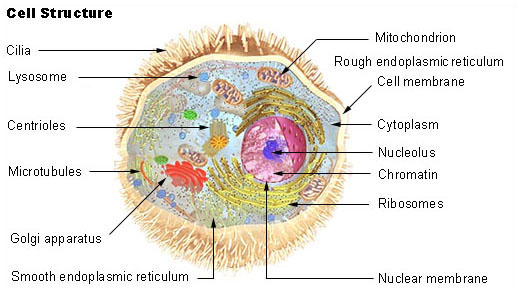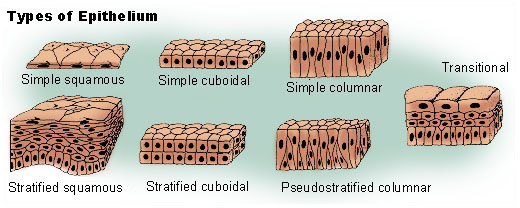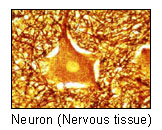| Cells, the smallest structures capable of
maintaining life and reproducing, compose all
living things, from single-celled plants to
multibillion-celled animals. The human body,
which is made up of numerous cells, begins as a
single, newly fertilized cell.
Almost all human cells are microscopic in
size. To give you an idea how small a cell is,
one average-sized adult body, according to one
estimate, consists of 100 trillion cells!
To learn more about cell structure and
function, select a topic listed below. |
|
|
Ideas about cell structure have changed considerably
over the years. Early biologists saw cells as simple
membranous sacs containing fluid and a few floating
particles. Today's biologists know that cells are
infinitely more complex than this.
There are many different types, sizes, and shapes of
cells in the body. For descriptive purposes, the concept
of a "generalized cell" is introduced. It includes
features from all cell types. A cell consists of three
parts: the cell membrane, the nucleus, and between the
two, the cytoplasm. Within the cytoplasm lie intricate
arrangements of fine fibers and hundreds or even
thousands of miniscule but distinct structures called
organelles.
Cell membrane
Every cell in the body is enclosed by a cell (Plasma)
membrane. The cell membrane separates the material
outside the cell, extracellular, from the material
inside the cell, intracellular. It maintains the
integrity of a cell and controls passage of materials
into and out of the cell. All materials within a cell
must have access to the cell membrane (the cell's
boundary) for the needed exchange.
The cell membrane is a double layer of phospholipid
molecules.
Proteins in the cell
membrane provide structural support, form channels for
passage of materials, act as receptor sites, function as
carrier molecules, and provide identification markers.
Nucleus and Nucleolus
The nucleus, formed by a nuclear membrane around a
fluid nucleoplasm, is the control center of the cell.
Threads of
chromatin in the
nucleus contain deoxyribonucleic acid (DNA), the genetic
material of the cell. The nucleolus is a dense region of
ribonucleic acid (RNA) in the nucleus and is the site of
ribosome formation. The nucleus determines how the cell
will function, as well as the basic structure of that
cell.
Cytoplasm
The cytoplasm is the gel-like fluid inside the cell.
It is the medium for chemical reaction. It provides a
platform upon which other organelles can operate within
the cell. All of the functions for cell expansion,
growth and replication are carried out in the cytoplasm
of a cell. Within the cytoplasm, materials move by
diffusion, a physical process that can work only for
short distances.
Cytoplasmic organelles
Cytoplasmic organelles are "little organs" that are
suspended in the cytoplasm of the cell. Each type of
organelle has a definite structure and a specific role
in the function of the cell. Examples of cytoplasmic
organelles are
mitochondrion,
ribosomes,
endoplasmic reticulum,
golgi apparatus, and
lysosomes. |
|
The structural and functional characteristics of
different types of cells are determined by the nature of
the proteins present. Cells of various types have
different functions because cell structure and function
are closely related. It is apparent that a cell that is
very thin is not well suited for a protective function.
Bone cells do not have an appropriate structure for
nerve impulse conduction. Just as there are many cell
types, there are varied cell functions. The generalized
cell functions include movement of substances across the
cell membrane, cell division to make new cells, and
protein synthesis.
Movement of substances across the cell membrane
The survival of the cell depends on maintaining the
difference between extracellular and intracellular
material. Mechanisms of movement across the cell
membrane include simple diffusion,
osmosis, filtration,
active transport,
endocytosis, and
exocytosis.
Simple diffusion is the movement of particles
(solutes) from a region of higher solute concentration
to a region of lower solute concentration. Osmosis is
the diffusion of solvent or water molecules through a
selectively permeable membrane. Filtration utilizes
pressure to push substances through a membrane. Active
transport moves substances against a concentration
gradient from a region of lower concentration to a
region of higher concentration. It requires a carrier
molecule and uses energy. Endocytosis refers to the
formation of vesicles to transfer particles and droplets
from outside to inside the cell. Secretory vesicles are
moved from the inside to the outside of the cell by
exocytosis.
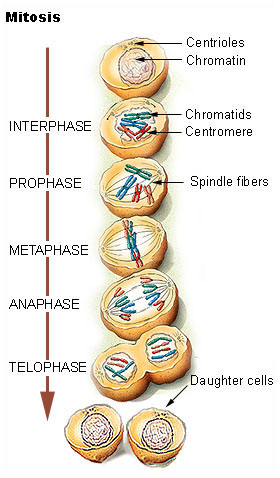
|
Cell division
Cell division is the process by which new
cells are formed for growth, repair, and
replacement in the body. This process
includes division of the nuclear material
and division of the cytoplasm. All cells in
the body (somatic cells), except those that
give rise to the eggs and sperm (gametes),
reproduce by mitosis. Egg and sperm cells
are produced by a special type of nuclear
division called meiosis in which the number
of chromosomes is halved. Division of the
cytoplasm is called cytokinesis.
Somatic cells reproduce by mitosis, which
results in two cells identical to the one
parent cell. Interphase is the period
between successive cell divisions. It is the
longest part of the cell cycle. The
successive stages of mitosis are prophase,
metaphase, anaphase, and telophase.
Cytokinesis, division of the cytoplasm,
occurs during telophase.
Meiosis is a special type of cell
|
division that occurs in the production of the gametes,
or eggs and sperm. These cells have only 23 chromosomes,
one-half the number found in somatic cells, so that when
fertilization takes place the resulting cell will again
have 46 chromosomes, 23 from the egg and 23 from the
sperm.
DNA replication and protein synthesis
Proteins that are synthesized in the cytoplasm
function as structural materials, enzymes that regulate
chemical reactions, hormones, and other vital
substances. DNA in the nucleus directs protein synthesis
in the cytoplasm. A gene is the portion of a DNA
molecule that controls the synthesis of one specific
protein molecule. Messenger RNA carries the genetic
information from the DNA in the nucleus to the sites of
protein synthesis in the cytoplasm. |
|
|
- tis·sue
- an aggregation of similarly specialized cells united in the
performance of a particular function.
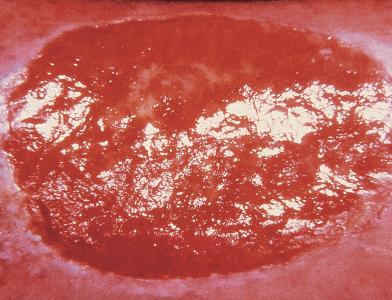
Tissue
accidental tissue, a tissue growing in or
upon a part to which it is foreign; it may be either
analogous
or
heterologous.
adenoid tissue,
lymphoid t.
adipose tissue, connective tissue made up of
fat cells
in a meshwork of
areolar
tissue; called also
fatty t..
adipose tissue, brown, a thermogenic type of adipose tissue
containing a dark pigment. It arises during embryonic life in
certain specific areas in many mammals, including humans, and is
prominent in newborns. It remains distinct and conspicuous in adults
in only certain species, especially those that hibernate. Cf.
white adipose
t. Called also
brown fat.
adipose tissue, white, adipose tissue, yellow, the adipose
tissue comprising the bulk of the body fat. Cf.
brown adipose
t.
adrenogenic tissue,
fetal zone of
adrenal cortex.
analogous tissue,
accidental
tissue that is similar to one found normally in other parts of
the body.
areolar tissue, areolar connective tissue, a type of
connective
tissue made up largely of interlacing fibers. Called also
cribriform t.
and loose
connective t.
basement tissue, the substance of a
basement
membrane.
bony tissue,
osseous t.
brown adipose tissue,
brown fat.
bursa-equivalent tissue, bursal equivalent tissue, a
hypothesized lymphoid tissue in nonavian vertebrates including human
beings, equivalent to the
bursa of
Fabricius in birds: the site of
B lymphocyte
maturation. It now appears that B lymphocyte maturation occurs
primarily in the bone marrow.
cancellous tissue, the loose spongy tissue of the interior
and articular ends of bone.
cartilaginous tissue, the substance of the cartilages.
cavernous tissue,
erectile t.
cellular tissue, loose connective tissue with large
interspaces.
chondroid tissue, an embryonic form of cartilage composed of
vesicular cells provided with elastic capsules and having
collagenous fibers in its interstitial substance. Called also
fibrohyaline
t. and
pseudocartilage.
chordal tissue, the tissue of the notochord.
chromaffin tissue, tissue composed largely of
chromaffin
cells, well supplied with nerves and vessels; it occurs in the
adrenal medulla and also forms the paraganglia of the body.
cicatricial tissue, the dense fibrous tissue forming a scar
or cicatrix and derived directly from granulation tissue; called
also scar t.
compact tissue, the hard external portion of a bone.
connective tissue, the tissue that binds together and is the
support of the various structures of the body. It is made up of
fibroblasts,
fibroglia,
collagen
fibrils, and
elastic
fibers, is derived from the mesoderm, and in a broad sense
includes the collagenous, elastic, mucous, reticular, osseous, and
cartilaginous tissue. Some authorities also include the blood. Cf.
fibroblast.
Connective tissue is classified according to concentration of fibers
as loose (areolar) and dense, the latter having more abundant fibers
than the former.
cribriform tissue,
areolar t.
dartoic tissue, dartoid tissue, tissue that resembles the
tunica dartos,
such as in a tumor with muscular elements; see
leiomyoma
cutis.
dense connective tissue, see
connective t.
elastic tissue, elastic tissue, yellow, connective tissue
made up of
elastic fibers, frequently massed into sheets.
endothelial tissue,
endothelium.
episcleral tissue, the loose connective tissue over the
sclera, between it and the conjunctiva.
epithelial tissue,
epithelium.
epivaginal connective tissue, connective tissue surrounding
the sheath of the optic nerve.
erectile tissue, tissue containing large venous spaces with
which arteries communicate directly, as in the penis and clitoris.
Another type formed of dilated venules occurs in the nasal mucosa.
The smooth muscle of the nipples constitutes another erectile organ.
extracellular tissue, the total of tissues and body fluids
outside the cells, including the plasma volume and all plasma
components, the extracellular fluid volume and its components, plus
the intercellular and extracellular tissue solids, most notably the
collagen, cartilage, bone, elastin, and other connective tissues of
the body framework and viscera.
extraperitoneal tissue,
fascia
extraperitonealis.
fatty tissue,
adipose t.
fibrohyaline tissue,
chondroid t.
fibrous tissue, the ordinary connective tissue of the body,
made up largely of yellow or white fibers.
fibrous tissue, white, that which is composed almost wholly
of collagenous fibers.
Gamgee Tissue, trademark for a surgical dressing consisting
of a thick layer of absorbent cotton between two layers of absorbent
gauze.
gelatiginous tissue, that which yields gelatin on boiling
with water.
gelatinous tissue,
mucous t.
glandular tissue, an aggregation of epithelial cells that
elaborate secretions.
granulation tissue, the newly formed vascular tissue normally
produced in the healing of wounds of soft tissue and ultimately
forming the cicatrix; it consists of small, translucent, red,
nodular masses or
granulations
that have a velvety appearance.
gut-associated lymphoid tissue, lymphoid
tissue associated with the gut (primordial digestive tube), including
the tonsils, Peyer patches, lamina propria of the gastrointestinal
tract, and appendix.
hematopoietic tissue, see under
system.
heterologous tissue, tissue unlike any other that is normal to
the organism.
heterotopic tissue,
choristoma.
homologous tissue, tissue identical with another tissue in
structural type.
hyperplastic tissue, tissue affected by hyperplasia.in dentistry,
an overgrowth of tissue about the maxilla or mandible that is
excessively movable, or more readily displaced than is normal.
indifferent tissue, undifferentiated embryonic tissue.
interstitial tissue,
stroma.
junctional tissue, the portion of the conducting system of the
heart forming a bridge between the atrium and ventricle of the heart,
comprising the atrioventricular node and the bundle of His.
Kuhnt intermediary tissue, glial tissue surrounding the optic
nerve and separating it from the retina.
lardaceous tissue, tissue having the appearance of lard as a
result of a degenerative process.
loose connective tissue,
areolar t.
lymphadenoid tissue, tissue resembling that of the lymph nodes,
found in the spleen, bone marrow, tonsils, and other organs.
lymphatic tissue, lymphoid tissue, a latticework of reticular
tissue the interspaces of which contain lymphocytes; lymphoid tissue may
be diffuse, or densely aggregated as in lymph nodules and nodes. See
also under system.
mesenchymal tissue,
mesenchyme.
metanephrogenic tissue, the
nephrogenic
tissue of the
metanephros; it gives rise to the
nephrons of
the permanent kidney.
mucosa-associated lymphoid tissue, a type of specialized lymphoid
tissue found in association with certain types of epithelia; it usually
has prominent B-cell follicles and sometimes has zones of T cells.
mucous tissue, a jellylike mucoid connective tissue, such as
occurs in the umbilical cord.
muscle tissue, muscular tissue, tissue specialized for
contraction, which produces movement of the body and its parts; it
consists of muscle fibers, muscle cells, connective tissue, and
extracellular material. Called also
flesh. See
also muscle.
myeloid tissue,
medulla ossium
rubra.
nephrogenic tissue, see under
cord.
nerve tissue, nervous tissue, the specialized tissue making up
the central and peripheral nervous systems; it consists of neurons with
their processes, other specialized or supporting cells such as the
neuroglia, and extracellular material.
nodal tissue, tissue made up of nerve and muscle fibers, such as
that composing the sinoatrial node of the heart.
osseous tissue, bone that has become ossified, whether normal or
of a pathologic change to soft tissue. Called also
bony t.
osteogenic tissue, that part of the periosteum adjacent to bone
and concerned in the formation of osseous tissue; any tissue capable of
generating bone.
osteoid tissue, uncalcified bone tissue.
parenchymatous tissue,
parenchyma.
protochondral tissue,
centers of
chondrification.
reticular tissue, reticulated tissue, connective tissue
consisting of reticular cells and fibers.
rubber tissue, rubber in sheets for use in surgery.
scar tissue,
cicatricial t.
sclerous tissues, a category that includes
cartilaginous,
fibrous, and
osseous tissues.
shock tissue, that tissue in the animal body which bears the
brunt of the antigen-antibody reaction in anaphylaxis.
skeletal tissue, the bony, ligamentous, fibrous, and
cartilaginous tissue forming the skeleton and its attachments.
splenic tissue,
pulpa splenica.
subcutaneous tissue,
tela subcutanea.
subcutaneous tissue of abdomen,
tela subcutanea
abdominis.
subcutaneous fatty tissue,
panniculus
adiposus.
subcutaneous tissue of penis,
tela subcutanea
penis.
subcutaneous tissue of perineum,
tela subcutanea
perinei.
sustentacular tissue, a non-nervous structure of the retina
composed of its
Müller fibers.
symplastic tissue,
symplasm.
target tissue, tissue, either in vivo or in vitro, against which
humoral or cell-mediated immunity is directed.the tissue that responds
specifically to a given hormone.
tuberculous granulation tissue, the tissue that forms the
characteristic tubercle in tuberculosis, composed of epithelioid cells
in concentric masses, lymphocytes, and often Langhans giant cells.
vesicular supporting tissue,
chondroid t.
|
| Tissue is a group of cells that have similar
structure and that function together as a unit.
A nonliving material, called the intercellular
matrix, fills the spaces between the cells. This
may be abundant in some tissues and minimal in
others. The intercellular matrix may contain
special substances such as salts and fibers that
are unique to a specific tissue and gives that
tissue distinctive characteristics. There are
four main tissue types in the body: epithelial,
connective, muscle, and nervous. Each is
designed for specific functions. Use the
hyperlinks below to branch into a tissue type
and learn more about the topic.
|
|
|
| Epithelial tissues are widespread throughout the
body. They form the covering of all body surfaces, line
body cavities and hollow organs, and are the major
tissue in glands. They perform a variety of functions
that include protection, secretion, absorption,
excretion, filtration, diffusion, and sensory reception.
The cells in epithelial tissue are tightly packed
together with very little intercellular matrix. Because
the tissues form coverings and linings, the cells have
one free surface that is not in contact with other
cells. Opposite the free surface, the cells are attached
to underlying connective tissue by a non-cellular
basement membrane. This membrane is a mixture of
carbohydrates and
proteins secreted by the epithelial and connective
tissue cells.
Epithelial cells may be squamous, cuboidal, or
columnar in shape and may be arranged in single or
multiple layers.
Simple cuboidal epithelium is found in glandular
tissue and in the kidney tubules. Simple columnar
epithelium lines the stomach and intestines.
Pseudostratified columnar epithelium lines portions of
the respiratory tract and some of the tubes of the male
reproductive tract. Transitional epithelium can be
distended or stretched. Glandular epithelium is
specialized to produce and secrete substances. |
|
Connective tissues bind structures together, form a
framework and support for organs and the body as a
whole, store fat, transport substances, protect against
disease, and help repair tissue damage. They occur
throughout the body. Connective tissues are
characterized by an abundance of intercellular matrix
with relatively few cells. Connective tissue cells are
able to reproduce but not as rapidly as epithelial
cells. Most connective tissues have a good blood supply
but some do not.
Numerous cell types are found in connective tissue.
Three of the most common are the
fibroblast,
macrophage, and
mast cell. The types of
connective tissue include loose connective tissue,
adipose tissue, dense fibrous connective tissue, elastic
connective tissue, cartilage, osseous tissue (bone), and
blood.
|
|
| Muscle tissue is composed of cells that have the
special ability to shorten or contract in order to
produce movement of the body parts. The tissue is highly
cellular and is well supplied with blood vessels. The
cells are long and slender so they are sometimes called
muscle fibers, and these are usually arranged in bundles
or layers that are surrounded by connective tissue.
Actin and myosin are contractile proteins in muscle
tissue.
Muscle tissue can be categorized into skeletal muscle
tissue, smooth muscle tissue, and cardiac muscle tissue.
Skeletal muscle fibers are cylindrical,
multinucleated, striated, and under voluntary control.
Smooth muscle cells are spindle shaped, have a single,
centrally located nucleus, and lack striations. They are
called involuntary muscles. Cardiac muscle has branching
fibers, one nucleus per cell, striations, and
intercalated disks. Its contraction is not under
voluntary control. |
|
|
|
Nervous tissue is found in the brain, spinal
cord, and nerves. It is responsible for
coordinating and controlling many body
activities. It stimulates muscle
contraction, creates an awareness of the
environment, and plays a major role in
emotions, memory, and reasoning. To do all
these things, cells in nervous tissue need
to be able to communicate with each other by
way of electrical nerve impulses.
|
The cells in nervous tissue that generate and conduct
impulses are called
neurons or nerve cells.
These cells have three principal parts: the
dendrites, the cell
body, and one
axon. The main part of
the cell, the part that carries on the general
functions, is the cell body. Dendrites are extensions,
or processes, of the cytoplasm that carry impulses to
the cell body. An extension or process called an axon
carries impulses away from the cell body.
Nervous tissue also includes cells that do not
transmit impulses, but instead support the activities of
the neurons. These are the glial cells (neuroglial
cells), together termed the
neuroglia. Supporting,
or glia, cells bind neurons together and insulate the
neurons. Some are phagocytic and protect against
bacterial invasion, while others provide nutrients by
binding blood vessels to the neurons. |
|
|

